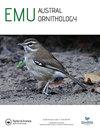南极褐贼鸥(Stercorarius antarcticus lonnbergi)的非繁殖行为:从模型换羽模式和稳定同位素分析的见解
IF 1.1
4区 生物学
Q3 ORNITHOLOGY
引用次数: 0
摘要
在非繁殖季节,海鸟的生活史和行为的长期变化可以反映环境条件的变化。然而,长期的海洋研究很少,特别是对南半球海鸟的研究。在这里,我们使用了86只棕色贼鸥(Stercorarius antarcticus lonnbergi)的换羽评分,这是一种在新西兰奥特罗阿查塔姆群岛繁殖的大型掠食性海鸟,以模拟初级羽毛换羽的时间和持续时间。此外,我们分析了62根现代(2014 - 2016)和10根博物馆尾羽的稳定同位素值(δ13C和δ15N)。这些数据提供了对褐贼鸥非繁殖行为的深入了解。有趣的是,我们的研究结果表明,初生羽毛蜕皮发生在鸟类离开群落之前,平均在1月2日±5天(SE)开始。初生羽毛平均在繁殖结束前5天(1月7日±10天)和离群前42天(2月13日±11天)开始换羽。初生羽毛平均换羽时间为189±14 d (SE)。重要的是,4只母贼鸥的低δ13C值表明,当贼鸥在殖民地时,尾羽也可能发生换羽。现代年和博物馆年的尾羽δ13C和δ15N值两两比较无显著差异。然而,2014年尾羽的δ15N值与2015年和2016年不同。在如此短的时间内,尾羽δ15N值的年变化如此之大,使得长期比较难以解释,特别是在样本量小的年份之间。虽然尾羽的稳定同位素分析提供了丰富的信息,但我们建议未来的贼鸥研究取样于主要的转换层,而不是尾羽。本文章由计算机程序翻译,如有差异,请以英文原文为准。
Non-breeding behaviour in the Brown Skua (Stercorarius antarcticus lonnbergi): insights from modelling moulting patterns and stable isotope analyses
ABSTRACT Long-term changes in the life history and behaviour of seabirds during the non-breeding season can reflect shifts in environmental conditions. However, long-term marine studies are scarce, particularly on southern hemisphere seabirds. Here, we used moult scores from 86 Brown Skuas (Stercorarius antarcticus lonnbergi), a large predatory seabird breeding on the Chatham Islands, Aotearoa/New Zealand to model both the timing and duration of primary feather moult. In addition, we analysed stable isotope values (δ13C and δ15N) from 62 modern (2014–16) and ten museum tail feathers. These data provide insights into the non-breeding behaviour of Brown Skua. Interestingly, our results show that the primary feather moult occurred prior to birds departing the colony, starting on average on 2 January ± 5 days (SE). The average start of primary feather moult occurred five days prior to the end of breeding (7 January ± 10 days (SD)) and 42 days before the birds departed the colony (13 February ± 11 days (SD)). The average duration of primary feather moult was 189 ± 14 days (SE). Importantly, low δ13C values in four females suggested that tail feather moult might also occur while skuas are at the colony. There was no difference in tail feather δ13C and δ15N values between any pairwise comparison of modern and museum years. However, values of δ15N from tail feathers sampled in 2014 were different from those sampled in 2015 and 2016. This large annual variation in δ15N values from tail feathers over such a short period makes long-term comparisons difficult to interpret, particularly between years with low sample sizes. While the stable isotope analyses of tail feathers are informative, we recommend future studies of skuas sample the primary coverts rather than tail feathers.
求助全文
通过发布文献求助,成功后即可免费获取论文全文。
去求助
来源期刊

Emu-Austral Ornithology
生物-鸟类学
CiteScore
2.00
自引率
7.70%
发文量
33
审稿时长
>12 weeks
期刊介绍:
Emu – Austral Ornithology is the premier journal for ornithological research and reviews related to the Southern Hemisphere and adjacent tropics. The journal has a long and proud tradition of publishing articles on many aspects of the biology of birds, particularly their conservation and management.
 求助内容:
求助内容: 应助结果提醒方式:
应助结果提醒方式:


